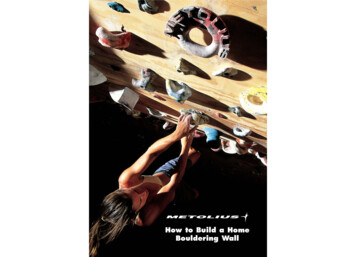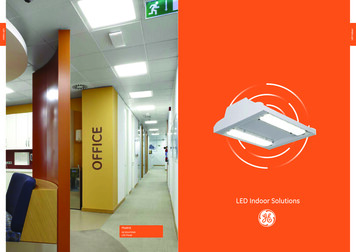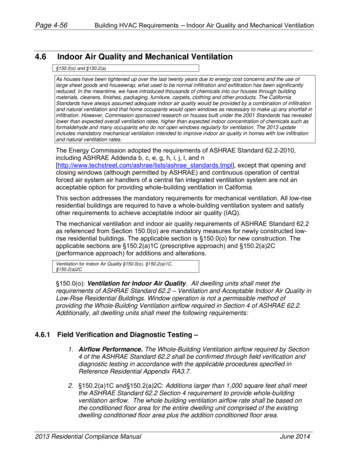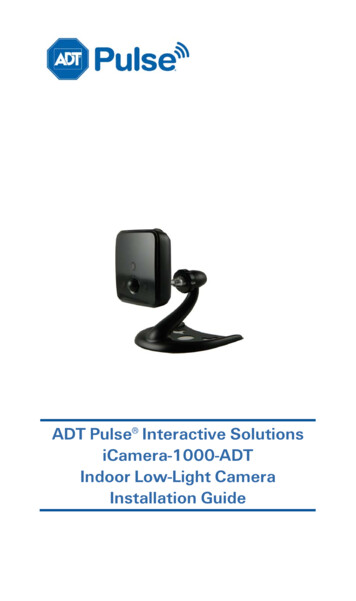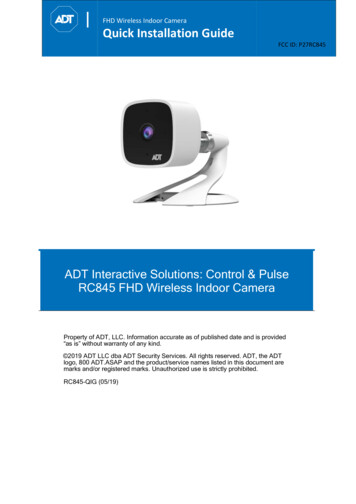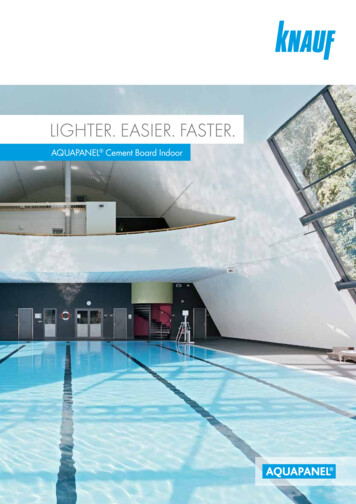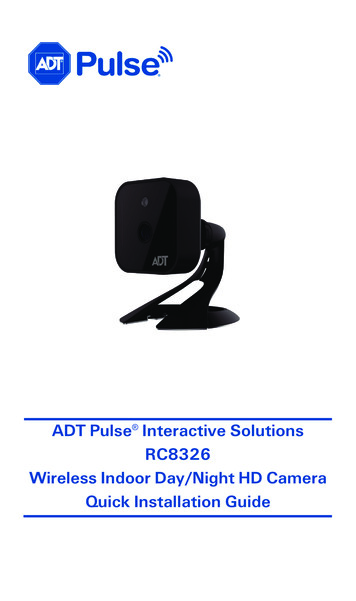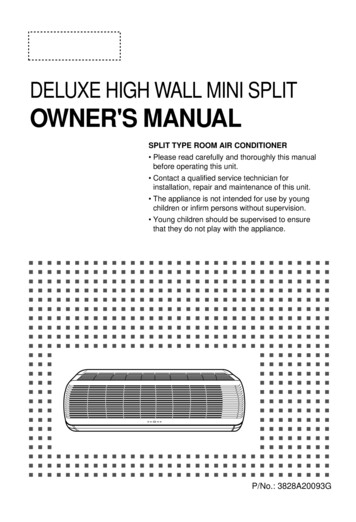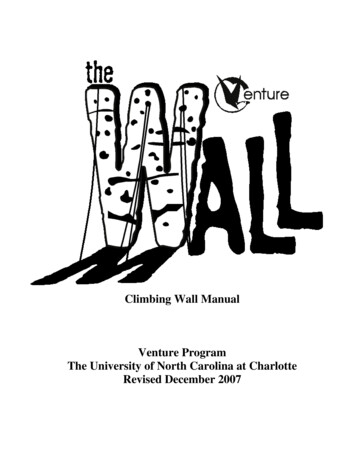
Transcription
Climbing Wall ManualVenture ProgramThe University of North Carolina at CharlotteRevised December 2007
Table of ContentsIntroduction/Wall Construction . 2Purpose . 3Venture Vision/Mission Statement . 3General Guidelines . 3Climbing Wall Set up and Take Down . 4-5Wall Access . 5Contraindications for Participation . 6Climbing Wall Monitoring. 6-7Climber Approval Cards . 6Belay Tag for Proficiency Test . 7Instructional Courses/Test. 8Proficiency Test Requirements . 8Safety Checks of the Wall . 9Wall Inspection Form . 9Equipment Requirements . 9-10Equipment Rental Fees . 10Equipment Strengths . 11Belaying and Climbing Procedures . 11-12Climbing Signals . 13Glossary of Terms . 13Staff Qualifications/Responsibilities. 14-16Route Setting . 17User Agreement Form . 18Venture Release and Hold Harmless Form . 19Emergency Protocol . 20Accident Incident Reporting . 20First Aid . 20Rescue Suggestions . 21Introductory Class Outline . 22-23Introductory Class Evaluation . 22-231
IntroductionFor many students, the climbing wall will be one of the major experiences they have with the Ventureprogram. It is a person-made challenge that emulates the experience of climbing on real rocks. Someindividuals will use the wall to practice, prepare for and to stay in shape for climbing outdoors. Others mayonly ever climb on indoor manufactured walls. In either case, their experience on our wall should be safe,challenging and fun. Participants should be made aware that climbing on an indoor wall is very differentfrom climbing outside on real rock cliffs and that they need additional training and experience to safely makethe transition to climbing outdoors. Some of the differences include: weather, setting anchors, loose rock,impact of other people in the area, insects and animals, route finding, etc.Students need time and encouragement to complete climbs in good style - not just rushed through. They mustdeal with the problems of height, agility, balance, strength and endurance, and various personal issues.Working through these issues will promote their personal development, confidence and joy. The staff shouldencourage experimentation, play and progress, not simply survival and getting to the top.Wall ConstructionThe climbing wall was designed jointly by Arête Climbing Systems with input from Venture staff. The wallwas built during November of 1997. The company Arête Climbing Systems was based out of Auburn, CA.Arête meets and exceeds the CWIG (Climbing Wall Industry Group) standards for construction.The wall was fully designed on site by experienced professionals. This is not a pre-fabricated wall; everyfeature (bulge, crack, roof, edge, slab, arête and chimney) was hand carved and formed on site. The naturalfeatures give the look and feel of real rock, but the wall also has numerous movable holds to give flexibilityin route setting. The wall sports a natural rock texture and color reminiscent of the local North Carolinaclimbing areas. The wall seems granite in nature with quartzite veins similar to Yosemite climbing.The wall ranges from 30-34 feet tall and 30 feet wide. The climbable surface area is 1,440 square feet. Thereare around 700 placements for holds; we have approximately 400 bolt-on holds. The brands of holds areFranklin, Metolius, Voodoo, Entre Prises, Pusher and Nicros. The wall also offers two cracks. One is perfectfor fingers and hands; the other has some thin fingers and is slightly more overhanging, ending in acrescendo of beautiful fingers and hands in a dihedral. There is also a chimney offering some off-width bodytechniques.Venture ProgramUniversity of North Carolina at CharlotteCone University Center9201 University City Blvd. Charlotte, NC 28223(704) 687-2486www.uncc.edu/venture2
The wall is in line with current climbing wall standards and adheres to the standards set forth by AEE(Association for Experiential Education). The Venture program is accredited by AEE.Purpose1. "To demonstrate in the most stunning way of all that there is no limit to the effort [one] can demand of[oneself]"--WalterWalter Bonatti.2. To empower and challenge all participants to reach beyond their personal limits – physically,mentally and socially – resulting in increased selfself-confidence.confidence. (Carolina Adventures)3. To experience making decisions ininvolving risk and courage.4. To promote trust and responsibility in self and belayer.5. To have FUN!!Venture Vision/Mission StatementThe mission of the Venture program enhances the educational mission of the University of North Carolina atCharlotte. We foster student development using experiential, “hands“hands-on” learning. We engage people in meaningful and challenging activities to address individual, leadership, communityand environmental issues. We strive to be a catalyst to increase the students sesensense of self worth and personal responsibility. We provide opportunities for the development of leadership qualities through training’s and positions ofresponsibilities. We design activities for small groups in which participants experience a sense of community,commteamworkand open communication. We regard the stewardship of our earth’s resources as a crucial focus. We promote the awareness andpreservation of the natural environment. Our ultimate commitment is to safety, quality programs, and responsible stestewardshipwardship of the earth.General Guidelines Any use of the Climbing Wall by nonnon-Venture personnel must be approved by the Venture Director (seeMonitoring Procedures). During operating hours, at least one qualified staff must be present to run the wall (see(StaffQualifications).3
Climbing Wall Set-Up1. Show your ID to enter the SAC at the ID Monitors Desk, go to the keybox location. Swipe your ID card.Enter your personal pin number. Open the door and removed key ring #38. It has 4 keys to the: closet,curtain, corner items & entrance gate. Go upstairs and open the closet. If need to raise the basketball goal, thebuilding manager’s number is x72950 and the remote control number is A8.2. Remove equipment storage box and the shoe organizer from closet. The second storage box containsrock holds, bolts, etc. and is to be removed only when necessary.3. Unclip/unlock metal cables from cinder block wall and attach back to the curtain. Unclip both green ropesand attach to each other so that they hang freely. Switch on the two power sources to the curtain motor.Insert key into curtain motor. Before operating, be sure that: everyone is clear of the area, all clips areunattached & no objects are in the motor or cable spool area. Push the “Raise” button once. Be near the“Stop” button in case of problems. Keep hands away from all moving parts. Once raised, remove keys andturn off power.4. Remove pads from Wall and set down on floor as a cushion for bouldering and rope stretch falls.5. Set bolts for anchoring into the floor and girth hitch daisy chains into eye bolts. Starting left to right, seteyebolts (#1-#6). Angle, eyebolts appropriately towards belay bars so that NOT the face of the bolt but thethin side of bolt, is facing belay bar. Washers on eyebolts are also important to help create the correct angleof placement.Required washers: #1 6 washers; #6 4 washers; #(all others) 2 washers6. Set up tables, chairs and boundary barriers/fences to mark off area. Organize informational flyers/handoutson table. Set up easels with posters. Set out sign-in sheet and card box.7. Individually and hands-on, inspect each rope and record the results in the daily equipment log. Organizethe ends of ropes by looping through daisy chains. Inform the Assistant Director of Programs of any unusualrope wear or damage.8. Inventory & inspect equipment and log in book. Inspect the contents of the 1st Aid kit and restock withsupplies if needed. Inform Assistant Director of Programs if anything is used other than Band Aids forminor scrapes.9. The first staff member at the Wall will do a cursory inspection before participants begin to climb. Staffmust assess the following potential problems and not hesitate to address the problems, or adjust, ordiscontinue the activity if necessary:a. use of the adjoining basketball or volleyball courtb. ropes appear tampered with or worn, holds appear loosec. time constraints- do not rush through because of tight schedulingTime pressure is a leading cause of accidentsd. participants not prepared mentally or physically4
Climbing Wall Take Down1. Daisy chain the ropes, tuck behind the pads as pads are standing up for tie down.2. Sweep floor of concrete dust and dispose of in the trash can near Wall.3. Insert key into curtain motor. Before operating, be sure that: everyone is clear of the area and that noobjects are in the motor or cable spool area. Push the “Lower” button once. Be near the “Stop” button in caseof problems. Remove key and turn off the two power sources. Attach the green ropes to eyebolts in thecinder block wall. Clip/lock the metal cables from the curtain to the cinder block wall.4. Inventory the equipment and store in appropriate boxes. If any equipment is missing, leave a message forthe Climbing Director as soon as possible. Log unusual rope wear on the rope log form. Organize climbingequipment and place in the operations box. Store in closet and lock door.5. Take down the table, chairs and fences and lock in the corner.6. Once a week, the assistant director will collect the money, receipts and # of climbers count. If largeamount is collected of 50 or more please inform the Climbing Director.7. Using your ID card and personal pin number, return key ring #38 to the key box.8. Report any issues, changes or needs to the Venture Director or Climbing Wall Director.Phone near Wall, located by women’s restroom: x 76970Venture Asst. Director for Climbing: x 73288SAC building manager, radio: x 72950UNC Charlotte Police: x 72200Climbing Wall AccessTo have access to climb the Venture Climbing Wall, all participants must be an Approved Climber and musthave access to the SAC. In order to access the SAC participants must be either a UNC Charlotte student, afaculty or staff at UNC Charlotte who has the Basic Fitness Membership, an escorted guest of an UNCCharlotte student, or be a participant in a scheduled Venture Program with their name on a Venture roster.The first time an individual comes to the wall to experience climbing, they must sign the waiver forms butthere is no cost for equipment rental but they must leave an ID with wall staff until they return theequipment and leave for the night. A Venture staff or an approved climber may belay them. If theindividual returns another night they need to pay for the rental and sign up for a climbing class. In themeantime, while they are waiting for a Climbing Wall Introduction Class, the individual will receive a cardshowing they have signed up for a climbing class so they may continue to come in and pay for rental feesto climb but they are not permitted to belay anyone.To become an Approved Climber, a participant: Must have either successfully completed a Climbing Wall Introduction class passing the BelayProficiency Test Just take the Proficiency Test within the current semester or Participated in the EXER 1233 Introduction to Rock Climbing academic course that included aBelay Proficiency Test during the current semester.This will include signing a Venture Climbing Wall Hold Harmless and User Agreement each semester.All “approved climbers” have an updated card in the card box at the Wall. (See page 6 for sampleApproved Climbers Card.)*Staff have the right to deny access to the wall for any individuals whom they considera safety risk to themselves or others.5
Contraindications for ParticipationBefore the first time they use the wall, each participant will be asked whether they have any of the followingconditions. If appropriate, limit access to the Wall for those who have contraindications for participation.Physician approval is required for participation for participants with any of these conditions:Contraindications for Participation High Blood Pressure ( 145/90) Unstable cardiovascular or respiratory conditions Active back or joint problems (recent or recurring injuries) Post-partum ( 6 weeks since giving birth) Uncontrolled diabetes, epilepsy, or seizuresStaff should be aware that preliminary research indicates that psychological fear (i.e. fear of height) canaccelerate an individual's heart rate as high as 180 beats per minute; this could strain a weak heart.Climbing Wall MonitoringMonitor the Wall users; keeping the area safe and providing encouragement and support. If someone getshurt or stuck, assist as necessary.Staff should discuss with each new participant their climbing experience, to judge whether to give them a BelayProficiency Test or refer them to a Wall Introductory Course. You might ask the following types of questions: Number of years of climbing experience & how recently they have climbed Level of climbing & type of climbing experience (indoor, traditional lead, sport, etc.) Proficiency in belay skills Experience in a climbing gym vs. outdoor climbingCheck participants names on the sign in sheet, get signed Waivers and Agreement Form for currentsemester, and check the date of their last Proficiency Test on their Climber Approval Cards from the cardbox. Collect any moneys. Record the data, with participant numbers, in the log and file waivers. Have allparticipants register on the sign in sheet. Approved climbers should move their card to the front of the box.All new approved climbers need a card filled out on them and stored in the card file box. (See sample below)Climber Approval CardsNameID NumberEmailEmergency ContactPhoneEm. Contact PhoneIntro ClassDate(first Prof. Test free after Intro. Class& belay practice time with a back-up)Proficiency Test: (you MUST re-test each semester)KNES Rock ClassTrad w/Trad w/opass / faildateTrad w/Trad w/opass / faildateTrad w/Trad w/opass / faildateTrad w/Trad w/opass / faildateTrad w/Trad w/opass / faildateSemesterVenture Rock TripDateDateVenture StaffDateVenture Wall StaffDateEquipment Rentals:Semester harness rental semesterSemester harness rental semesterSemester harness rental semesterTrad w/Trad w/opass / faildate(if you fail 3 Prof. Tests, applied to an Intro. Course in that semester)6
Have students remove objects from body that could lead to injury: specifically rings, loose bracelets,dangling necklaces and dangling ear rings. Encourage participants to remove hard or sharp objects fromtheir pockets that could cause injury such as pens, pencils, keys, etc. Participants may want to removewatches.If climber needs to rent equipment, record in the book on the rental form, collect ID and payment, and thenwrite a receipt and provide gear. When climber is ready to leave, collect gear, check off on rental form inbook and return their ID.At each climbing session, each climber/belayer must be observed by the Wall monitor. This is to insurethat even if a person knew how to belay a month ago or a year ago, he/she hasn’t forgotten the basics. TheWall monitor can approve a belayer for whom they have a high level of confidence, based on previouscontact. If a person is seen with a faulty belay they should be corrected and the proper method brieflyreviewed with them. If they are seen making another mistake, their belaying privileges will be suspendeduntil they successfully complete another Belay Proficiency Test.Belay Tags are issued to those who have passed the Belay Proficiency Test to provide a quick and easyvisual identification of who can belay solo. If a person does NOT have a Venture belay tag, they mayNOT belay solo until the pass the Proficiency Test. Instruct that the belay tags get worn on the right sidegear loop of their harness. Only the Senior and Instructor staff monitoring the wall may issue the belaytags. (See Sample Below)Climbing commands always initiated by the climber:ON BELAY? -climberBELAY ON. -belayerCLIMBING? -climberCLIMB ON. –belayerOnce climber is on ground, finished climbing, thebelayer states“belay off”Name:Instructor:Semester:7
Instructional Courses/TestsParticipants of the Wall Introductory Course must pre-register & prepay with the Assistant Director ofPrograms or Venture Secretary. The cost for this training is 15. The intro course will last approximately 3hours and will include instruction, practice belaying & knots, basic climbing techniques, climbing walletiquette, climbing philosophy and information on the limits of this training., (see Course Outline on theback.) Participants fill out an evaluation form afterwards. Participants must practice belaying and comeback to the Wall another time to take a Proficiency Test (cost of Test is included). Participant may not takethe belay proficiency test the same day they take the Introductory Course.**Warning: Please warn participants again that no matter how long a lesson they’ve taken, that they arejust at the beginning of the learning curve for rock climbing and should exercise caution and get as muchinstruction as they can. Indoor climbing is extremely different from outdoor climbing. Climb Smart! information is available to give to participants.The Proficiency Test will be offered when staff is able to both monitor the Wall and conduct these tests. Thetest takes around 10 minutes and consists of both a physical demonstration of competence and verbalexplanation of belaying issues. (see Prof. Test Requirements, next page). There is no cost for the BelayProficiency Test but must be retaken each semester. If the individual does not pass the Belay ProficiencyTest, they may retake the test at no cost only one extra time. If they do not pass it a second time suggestthat they take the Climbing Wall Introduction Class or talk to the Climbing Wall Director.Belay Proficiency Test RequirementsAll users must demonstrate the following skills before being allowed to use the Wall during open climbingsessions as an Approved Climber: Properly fit and wear a sit harness (tight enough, above hip bones, buckles double-backed) Tie into the harness with a figure eight follow through knot (must be properly dressed andbacked up with half of a double fisherman’s knot). The Figure eight needs to be approximately two inches of the harness and the keeper knot “backup knot” must sit on top of the Figure eight knot. When handed the rope, carabiners and belay device as separate pieces, participant is able tocorrectly set up to belay a climber. User should attach belay device into harness into thebelay loop and belay a climber. The user clips into ground anchor into belay loop so there is no slack in the daisy chain. correctly feed rope through belay device and attach to harness with locked carabiner Performs climber-check-belayer communication system Uses correct verbal signals and can perform safe, effective belay without ever letting go ofbrake hand. Tested on the ground with staff holding onto the rope as if a climber is on it, bycatching at least 3 test falls (once announced, one unannounced, with eye closed or adverted,catch another fall) and tested with a live climber and staff as back-up to catch 3 falls mentionedabove. Properly controls lowering of climber Demonstrate proper spotting technique for bouldering8
Safety Checks of the WallThe first staff member at the Wall will do a visual inspection before participants begin to climb. (seeClimbing Wall Set-Up) daily: check equipment storage area and report any missing gear to Climbing Directorhands on and visual inspection of each of the ropes, visual impaction of hand holds,check wall, curtain, courts and surrounding areaweekly: Brief the Assistant Director of Programs how the week went.twice per semester: check holds and tighten any loose ones (see below) and organize the equipmentstorage areatwice per year: wall inspection formWall Inspection FormCompleted once per year by the Climbing Director with the help of the SAC staff. This form is kept on filein the Venture office.1. Visually inspect the entire wall for cracks 1/8” or larger, which may indicate shifting of the wall. Visuallyinspect wall for stains (blood, dirt, etc.) and clean as appropriate.2. Visually and by touch inspect the exposed portions of the belay bars, especially the welds. Inspect the wallnear the belay bars, including the top of the wall above the bars.3. Manually check with hands every hold and tighten loose ones. Brush holds and cracks free of concrete andchalk dust.4. Inventory and inspect all equipment.5. Visually inspect ground anchors & curtain equipment.6. Check pads for any damage and clean.7. Check that nuts are secure on belay bar bolts on back side of the wall.Equipment RequirementsPlease help participants take care of the equipment. Do not allow anyone to step on, drag or rub liquids intoany equipment. Inspect for thin, flat or soft spots, excessive wear, nicks or burrs. Report any excessivedamage. Protect from abrasion points, sunlight, heat and petroleum-based or nylon-damaging substances.Use all equipment “lightly”.*Participants will use a provided harness or a harness that has been examined by the wall staff to determineits suitability.Identifying an acceptable harness: Harness is NOT older than 5 years to current year in.o Most year of harness tag can be found either stitched in leg loops or waist band. There is no fraying of webbing or stitching. Inspect the belay loop and it should have a minimum of four rows of stitching to be permittedfor use of. Clean and looks as if cared for. If questionable, provide Venture harness, and request it to be inspected by CORE staff withsignature if approved for use.9
Make sure the harness is locked by bringing the waist strap back through the front side of the buckle. Ifusing a harness with two loops for tying into, it is imperative that the climbing rope be tied into bothloops. Never tie directly into a belay loop. Personal harnesses must have leg loops, be tied according tomanufacturer’s directions and have no frayed or broken stitching.Staff should be familiar with multiple designs. Harnesses should not be placed over bulky clothing that could pull out during the climb andresult in a loosened harness Proper Adjustment: First tighten waist belt while leg loops are loose, then tighten leg loops Waist loop then needs to be double backed Leg loops should be back-threaded through buckle If participant is to use belay loop for anchor or to belay Gri Gri from, staff must inspect andsee four rows of stitching on the belay loop.A chest harness should be added to a participant whose body may not allow a sit harness to protect him/herproperly. If a chest harness is used, the climbing rope will be run through a carabiner on the chestharness or be connected by a carabiner and a prusik to the chest harness.Participants are encouraged to use a mechanical belay device (ATC) provided by Venture. Participants mayuse their own mechanical belay devices once it is approved by climbing wall staff. Other approved belaydevices include: ATC, Tuber, Pyramid, Stitch Plate, Gri-Gri and Super 8’s (used like a Stitch Plate).However, carabiner brake bars may not be used for belaying at the Venture Wall. Use locking carabinersonly. The carabiner on all belay devices must go through with the exception of the Gri Gri must gothrough the harness through the cross bar and waist belt. The Gri Gri Carbiner may go through the belayloop.Climbing shoes or sneakers or light hiking boots are all appropriate footwear. Shoes that are dirty and trashup the floor or that leave tread prints on the rock can be banned from use. Bare foot climbing is notallowed. Open-toed sandals are not allowed and neither are heavy mountaineering boots or other hard soledshoes.Helmets do not need to be worn. A helmet can be provided at no charge.Closed chalk balls are the only acceptable chalk allowed. Participants can bring their own chalk bags butthese must be free of loose chalk. The rationale for this is that since our wall will not be cleaned by theoccasional rain storm, it is our responsibility to keep the wall clean and to keep loose dust from the air(which can adversely effect other users of the facility).Equipment Rental FeesParticipants renting Venture gear must leave their ID card in exchange for the gear. The card will be returnedupon return of equipment- or if equipment is not returned, upon payment. All equipment can be shared withother wall users. Participants can pay for rentals at the wall or at the Venture office. Wall staff should acceptVenture receipts for payment. Harness: 3.00 per session or 10.00 per semesterShoes: 2.00 per session or 20 for the semester (no semester rentals)Chalk bag: no chargeCarabiners: no chargeHelmet: no charge10
Equipment StrengthsKnowing the strengths of the different types of equipment used at the wall is useful for your own comfort asa staff person and to be able to assure participants of the soundness of the safety systems. Memorizing exactnumbers is not important, but it is helpful to have a ball park estimate of how strong materials are. By way ofcomparison, 2000 Lbs. roughly equals a ton. *Lbf. is pounds of force. SWL is Safe Working Load.ABC HarnessesAluminum locking carabinersWall ropesFloor anchorsDaisy chainsBelay bars SWL3500 - 4000 lbs.5500 lbs.2113 lbs.*(The figures provided are the4400 lbs.minimum breaking strength or5000 lbs.tensile strength. SWL is 20% of the4400 lbs.strength.)Climbing wall ropes are currently retired each year, at the beginning of each Fall semester.Belaying and Climbing ProceduresRatio Standards:For the indoor climbing wall, the standard ratio will be 1:12 for open climbing assuming the participantshave all passed belay tests. The more common ratio in this situation will be 1:10 with the potential for 1:15when conditions warrant (ex. in the credit rock climbing class after students have developed strong belayingskills). For climbing wall-training courses the ratio will be no greater than 1:7. If ratio continues to exceedstaff to participant ratio inform the Climbing Director.Belay Check: We use a belayer-check-climber and climber-check-belayer system before each climb. Thisincludes checking each others’: harnesses (that it is fitted correctly and buckle is backed-up correctly) figure eight knot (tied & dressed correctly in correct place with approved back-up knot) The Figure eight needs to be within two inches of the harness and the back up knot must sit on top of theFigure eight knot. * belay device (threaded correctly, that the belay devise is hooked into the harness into the belayloop and carabiner squeeze c
from climbing outside on real rock cliffs and that they need additional training and experience to safely make the transition to climbing outdoors . Some of the differences include: weather, setting anchors, loose rock, impact of other peo
